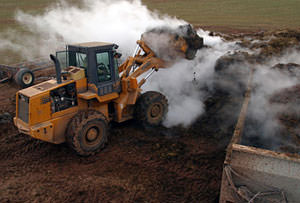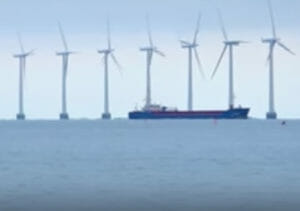The Electricity in Your Garbage
With biomass pioneers advancing their technology, the smelly stuff that you throw away today may be providing electricity for your home tomorrow.Almost like magic, biomass developers are tapping more and more kinds of waste to produce clean, renewable energy.
Gather ’round, dear readers, and I’ll tell you a little story that stinks. Even though it is filled with disagreeable smells, I think it will please you, especially if you’re among those folks who would rather not live in a dark, cold world. It’s a tale of “biomass,” that stuff that often starts out rank but ends up producing sweet, clean power.
Biomass is a word that’s new to most people, and you aren’t likely to hear it tossed around over Sunday dinner at Auntie Myrtle’s. But you can bet you will be exposed to it plenty in coming years.
Although the term has several definitions, here it is used to mean piles or containers of organic matter that can be tapped for energy. The list of biomass materials is long—agricultural and food waste, wood chips, yard clippings, microorganisms, animal byproducts and many other things.
Among the prime fodder of biomass scientists are hundreds of substances that aren’t bashful about giving off sinus-clearing scents. Yes, many of today’s biomass pioneers just love castoffs that reek. These men and women dance through a universe of aromas that are not welcome in the better parts of town. The stink from cow pies. From chicken dirt. From festering mountains of garbage. And, hold on to your tear glands, even rivers of onion juice.
On July 17, the Los Angeles Times ran a story about a Southern California farming company that is using onion juice to generate electricity and to save, it projects, more than $1 million a year. The company, Gills Onions, with only about 450 employees, isn’t some AIG-size conglomerate, but it thinks big: It will shave $700,000 a year off the electricity bill at its 14-acre plant in Oxnard by burning biomass fuel in a system that also will reduce the company’s waste disposal cost by $400,000 annually.
The system, called the first of its kind to convert onion waste into electricity, was unveiled last month. (Click here to see a picture of Gills’ anaerobic digester and a diagram of the system.)
Co-owner Steve Gill explains that the plant uses two fuel cells in creating electrical current. The procedure starts with the 150 tons of waste produced daily in the processing of onions for supermarkets and other buyers. From each day’s waste is extracted 30,000 gallons of pungent onion juice, which is mixed with microorganisms provided by brewer Anheuser-Busch (“This bacterium’s for you”?). And, voilà! … biogas — burnable methane that ultimately yields enough electricity to run the plant’s extensive refrigeration and lighting. I’m oversimplifying all this, but you get the idea: A company will save major money by using solid waste that normally would be discarded or sold for fertilizer or cattle feed.
Gill, who says the company has received more than $3 million in government and utility incentives, estimates that its $9.5 million investment in the power-generation system will pay for itself in less than six years. And—this will make you greenies out there happy—as much as 30,000 tons of “carbon dioxide-equivalent emissions” are being eliminated each year. That cutback of CO2 won’t reverse global warming, but I promise you it won’t make it worse.
In this case, everyone seems to be winning: business, Southern California and the planet. What more could a child of Mother Nature hope for? A technologically innovative firm is creating substantial amounts of clean electricity while lightening the agricultural waste stream by thousands of tons a year.
But don’t pop the Dom Pérignon just yet. It’s one thing to operate a biomass system at a single location but quite another to deal with the daunting problems of science, infrastructure, expense and human habit that stand in the way of, say, a nationwide biogas system. An expert quoted in the L.A. Times article says broad-scale use of biogas faces big barriers in the near term: “There’s no silver bullet. The technology isn’t quite there.”
It’s important to note Steve Gill’s mention of government and power company incentives. Undoubtedly these were factors in his company’s decision to make the heavy upfront financial investment necessary to design, build and install the biomass system. Government on every level, as well as private industry, should be working overtime to find ways to stimulate efforts by individuals, companies and institutions to reduce America’s dependence on the dirty-burning coal and petroleum fuels that are choking us. Plenty has been written about the gargantuan amounts of poisons that are spewing into our air and polluting our soil and groundwater. Enough said. The clock is ticking.
The federal government apparently has started to wise up and is boosting funding for renewable energy. Clearly that is needed. According to a commentary on EnergyBulletin.net, “The main beneficiaries of more than $700 billion of federal energy incentives over the past five decades have been the oil and natural gas industries … with 46 percent of the roughly $725 billion in federal support going to the oil sector. Our new report shows that the oil industry has benefited from $335 billion in combined incentives. …[R]enewable energy has received six percent ($45 billion).” So, $335 billion for oil and only $45 billion for renewables over five decades. Surely that imbalance has been at least a tiny factor in America’s current energy, pollution and climate predicaments.
Federal funding will be key to progress in biomass and other renewables. A university-affiliated energy expert quoted in the July issue of Biomass Magazine says that “[p]olicy and legislation are crucial in moving forward” and points to the Energy Independence and Security Act of 2007, the American Recovery and Reinvestment Act of 2009, and the landmark climate bill now pending in Congress. It is heartening to see that the recovery act, however dubious some of its other provisions might be, provides $78 billion for renewable energy projects, green transportation and energy efficiency. That sum alone far exceeds the $45 billion that Washington spent on incentives for renewables over more than 50 years.
Further billions for renewable energy are contained in the climate bill — the proposed American Clean Energy and Security Act — which is awaiting Senate action after narrowly clearing the House in June. (This legislation contains the controversial “cap and trade” provisions.) Under the legislation, utilities would have to generate 15 percent of their electricity from biomass, solar, geothermal, wind and other renewable sources within roughly 10 years, by 2020.
There was news last month of even more federal money becoming available to the public. Agriculture Secretary Tom Vilsack announced that his department is accepting applications for up to $50 million in projects that foster biofuel production and use.
Present and proposed clean-energy funding is large but not large enough, according to some. In July, 34 U.S. Nobel laureates sent President Obama a letter urging him to press for additional research and development funding in the climate bill. They want a clean-energy technology fund that would cost $150 billion over 10 years, a proposal that Obama has called for.
Common sense and recognition of the world’s climate and energy crises dictate that Washington be generous across the board in promoting clean-energy endeavors like the one at Gills Onions. And like those at Minnesota’s Haubenschild Farms, a dairy company that has operated biogas-generating equipment for the last 10 years and is now among a number of companies trading in “carbon credits.”
In the distance I hear some green warriors crying out that nothing about a cattle operation can be laudatory, but I won’t get into that briar patch here. (For a look at the activities of Haubenschild — which has no shortage of cow flops — and at how carbon credits work, click here.)
One of the non-barnyard animals that has found a role in the green scheme is the exotic and lovable panda. Which of course raises the question: Does a panda bear squat in the woods? Indeed it does. And it does the same in animal reserves, where the dung can be gathered up. I’d like to tell you that this collected scat is being used to power half of China, but that would be a fib—the panda is not producing biofuel, at least not yet. What the recycled droppings are being used for is to make pricey paper, as well as puppets, brush pots and souvenirs. Chinese researchers got the idea for the panda paper, some of which is said to smell like the fresh bamboo that pandas eat, from a zoo in Thailand that sells popular souvenirs made of panda and elephant feces.
American canines, not willing to play underdog to Chinese pandas, also are contributing to recycling. Here’s just one instance. The East Bay Municipal Utility District—MUD to Northern California’s Bay Area residents—is using dog waste to power some of its equipment. In a telephone interview with Truthdig last month, a spokesman for the company that does the collecting said the waste is picked up from a small number of facilities where there are dogs and is fed into utility district digesters that convert it into clean-burning methane.
Being clever with manure is not confined to the land of Yankee ingenuity. Here are only a few of the thousands of examples of biomass progress across the pond, westward and eastward: Biogas from chicken droppings has been used to power a Stirling engine in Japan. In the Netherlands, the world’s largest biomass power plant is burning gas from chicken excrement to supply electricity to 90,000 homes. Scotland soon will have a plant that will allow whisky drinkers to claim they are merely helping the biomass revolution. Permission has been granted to a biomass company and a distilling consortium to construct a plant that will use smelly residues from the distilling process, along with other renewable materials, to generate enough electricity to serve about 9,000 homes. Similar efforts involving distillery and brewery residues have been launched elsewhere in Europe and in the United States.
Even with its gains, biomass technology is still a mere babe requiring dutiful care and feeding. Government, industry and society in general must confront major challenges in developing biomass systems that can break through existing roadblocks and help provide the widely distributed renewable energy that the planet needs so desperately. A major undertaking, sure, but one that holds the potential for an extremely large payoff.
In the Middle Ages, alchemists fervently worked, without success, to turn lead into precious minerals. Today, as natural resources are depleted, thousands of scientists, researchers and developers are working earnestly with biomass materials to find low-cost, efficient and practical ways to draw out something of great worth—clean, renewable energy. Prominent among the materials that fill their daytime labors and nighttime dreams is one of high promise that has insulted the human nose ever since human noses began and that, for many of us, is best kept out of sight and smelling range. To biomass scientists, it is an object of shining hope: To you it’s poo, but to them it is pure gold.
T.L. Caswell worked for many years at the Los Angeles Times and now edits for Truthdig.
Your support matters…Independent journalism is under threat and overshadowed by heavily funded mainstream media.
You can help level the playing field. Become a member.
Your tax-deductible contribution keeps us digging beneath the headlines to give you thought-provoking, investigative reporting and analysis that unearths what's really happening- without compromise.
Give today to support our courageous, independent journalists.




You need to be a supporter to comment.
There are currently no responses to this article.
Be the first to respond.